

EAP Publications | Virtual Library | Magazine Rack | Search
Join the Ecological Solutions RoundtableEAP Publication-2
In this paper I will examine three contentions, that:
Before dealing with the first point I would like you to imagine, for a moment, some distant hypothetical time in the future. Convenient techniques are available whereby each individual can accurately determine his or her own unique nutritional requirements (Ch. 41-49 in Dickey 1976a, MacKarness 1977, Rapp 1975). It has finally been established that most infants should ideally receive nothing but breast milk for at least the first six months of life and that when solid foods are introduced, this is carried out in a particular sequence and on a rotational basis, most foods not being eaten more often than every four or five days (Binkley and Stigler 1976, Binkley,1977). These foods and, in fact, the foods eaten by everybody constitute a far wider range than we currently eat (Corwin 1976). They are mostly locally grown, eaten in season, and minimally processed or cooked (Hill and Ramsay 1977a). Raw milk is no longer consumed (Oski and Bell 1977, see also Gerrard 1973) and red meat constitutes a far smaller component of the diet than at present (Lappé 1975). Nobody is overweight as it has been discovered that food addiction (Randolph 1976a) and associated lethargy (Crook 1974, Dickey 1976b, MacKarness 1976, Randolph 1976b) are preventable in infancy by following the above procedure; and its control later in life may be achieved by identifying the offending foods and removing them from the diet (Dickey 1976c, MacKarness 1976, Rinkel et al. 1951, Rowe and Rowe 1972).
Under the above conditions the food needs of any population would be known and, given a number of other changes in society, agriculture could be planned, on a regional basis, to satisfy known food--needs. The energy requirements of such a food system would be a fraction of that required by the present one and could be supplied by renewable resources (Hill and Ramsay 1977a, Merrill 1976). Pollution from the food system and the associated hazards to health would be virtually non-existent (Hill and Ramsay 1977a,b). Other changes at that time might include a more dispersed population (Chen and Lagler 1974) and more decentralized political power (Bookchin 1971). Parts of this hypothetical vision, while unfamiliar to the majority, are being followed successfully by a significant proportion of the North American population today (Golos 1976, HEAL 1977, Kulvinskas 1976). I will return to this later, but first we must examine the dominant components of the current food system, and their effects on food consumptior and human health.
A U.S. medical doctor once aptly described the average North American as "overfed but undernourished" (Wood 1910). This was well documented in the recent Nutrition Canada (1975) National Survey, which, among other things, found that 50 per cent of Canadian adults are overweight and, of these, up to 10 per cent of males and 30 per cent of females are obese, i.e., their food (energy) intake is out of balance with their energy use (Fig. 1). Unfortunately being overweight may increase susceptibility to a number of diseases and consequently shorten one's life; or, as it has been more colourfully stated, "increasing one's waistline can shorten one's lifeline" (Table 1). The increased production necessary for this overconsumption places an extra burden on our dwindling non-renewable resources and on the environment in the form of extra wastes and pollutants (Hill and Ramsay 1977a,b). Clearly, something must be done to avoid this situation.
In order to correct the problem of obesity we should first be aware of the many factors that can influence it (Fig. 1). There is often a tendency among modern medical researchers, as with researchers within other disciplines, to look for single simple solutions to problems (Hill and Ramsay 1977a,b). In reality, most problems are complex and require a management approach comprising a number of different strategies (Hill 1977 a,b, Hill and Ramsay 1977b). Thus, rather than searching for magical slimming drugs, researchers (and obese individuals) should be learning how to manage such variables as those listed in Figure 1. However, even this approach will not be successful unless some changes are made at other points within the food system, including the production phase.
The role of the farmer within the food system has evolved from largely supplying people directly with elemental foods to supplying processors with the raw material from which "food" artifacts are made. Unfortuantely there appear to be some similarities between the attitude of food processors and that of producers of non-consumable commodities. Thus, a processor advertizes a product, a demand for a raw material is created and the farmer, if he wishes to stay in business, is forced to supply that demand. For example, many potato producers must produce primarily for the processed rather than the raw potato market, as the former is far more actively promoted that the latter. As a result, consumers spend more on many foods in their processed than in their elemental states and at the same time receive less for their money (Hall 1974, Pers. Comm.1977). The effect of processing on the price of potatoes is given in Table 2, and on nutrition content and energy efficiency in Figures 2 and 3.
If agriculture is to meet its often stated goal of nourishing people, it must have a more direct relationship with the consumer, and governments must provide far more leadership, e.g., using the pathways and strategies suggested in Figure 4. To state, as they do in the recent Food Strategy for Canada (Whelan and Abbott 1977), that "as more processing, packaging and service is added to raw food products, it is likely that this sector of the food system will attract more attention" by Government, is clearly evidence that industry is calling the tune and Government is tagging along behind "fiddling with the fine-tuning of the status quo" (Hill and Ramsay 1977b). What is needed is a forward thinking food policy such as that given in Table 3 (cf. Belden & Forte 1976, Blanche 1977a,b, Royal Norwegian Ministry of Agriculture 1976). A significant number of people, particularly urban dwellers who have returned to the land or others who have learned how to prevent ill health through the management of their life-style, especially their exposure to offending foods and chemicals, have recognized the need for the kinds of policy statements listed in Table 3 and are attempting to put them into practice (HEAL 1977). These will be examined in more detail in the final part of this paper.
One of the main factors hindering the implementation of preventative approaches to problems (such as overconsumption) is overspecialization. This is evident throughout the food system, not only at the production level, but also in academia and government (Figure 5). Recognizing the need for coordination and collaboration between the divisions involved, Professor Lindsay Robb, in Britain, argued for a single Ministry of Health and Land use (salfour 1975). The fact that the Federal Department of Health and Welfare played only a minor role in the formulation of the recent "Food Strategy for Canada" (Whelan and Abbott 1977) is evidence of the continuing lack of cooperation and coordination between the divisions involved in the soil-food-health chain.
Another effort to link the medical and agriculture disciplines is illustrated by the so-called "Medical Testament" issued in 1939 by the Cheshire Medical Committee in England, representing 600 general practitioners. In 1957 it was reprinted in The Lancet and signed by 400 additional doctors and dentists (Balfour 1975). A portion of it reads as follows:
"...we and a growing number of professional colleagues, together with many veterinarians, farmers, horticulturists, and others, concerned with the health of livestock and crops, have become increasingly aware of the fundamental importance of the relationships between soil, plants, animals and man.
"We believe that the task of preventing disease is bes envisaged as the enhancement of positive health and that, i this task, nutritional research should play a leading part.
"We believe, further, that any such research which fails to take into consideration the soil on which the food is grown, and the farming practices involved, must be accounted incomplete. This belief is in no way modified by the fact that much food is subjected to chemical and mechanical treatment after it leaves the land, flour being an outstanding example. Such treatment also is of deep concern to us, though it cannot be discussed here. We would, however, observe that it may well depress still further any reduction in food values that may be attributable to current agricultural practices
"We would urge, therefore, that any research designed to discover which methods of soil management result in the highest food values should receive our professional support and that such research should be both comprehensive in scope and of long term - extending over several decade' rather than years".
Unfortunately, this research still remains to be done within the Agricultural Colleges, although valuable contributions have been made by private research institutions, e.g., Balfour 1975, Bio-Dynamic Farming and Gardening Association, Price-Pottenger Nutrition Foundation, Pye Research Centre, Research Institute of Biological Husbandry.
More recently a number of ecologists have argued that in order to assure the survival of our species we must conform to a number of "Laws of Nature" (Table 4) (Commoner 1970, Etté and Bower 1975, Hill and Ramsay 1977b, Dansereau 1966). The development of a rational food system must be based on this kind of understanding of our support environment (Hill 1977b,Merrill 1976). Key features of such a system include the use of preventative and management approaches to problems (Fig. 6).
Parallel attempts to develop preventative and management approaches to poor health, including obesity, have been developed by a group of doctors who refer to themselves as Clinical Ecologists (Dickey 1976a, MacKarness 1976, Randolph 1962, Rinkel et al. 1951, Rowe and Rowe 1972). Basically they have found, as Roger Williams (1956) has, that individuals differ enormously both in their nutritional needs and tolerances to "poisons" and that what can be nutritious for one individual may be "poisonous" for another, or even for the same individual at another time in his or her life. They have also found that repeated exposure to foods or chemicals tends to result in adaptation, which in turn leads to addiction and the production of negative side-effects. The mechanism involves the production of stimulatory corticoids from the adrenals (Adolph 1956, Selye 1956) and probably and probably also bradykinis (Bell 1975a,b). The curative (and preventative) solution, with respect to food, is to identify the offending components of the diet and eliminate them. Some of these may be reintroduced, in rotation, at a later date i.e., not more often than every four or more days depending on the severity of the addiction. I suspect that tolerance to repeated exposures to foods and chemicals could be improved within the population if infants follow the "hypothetical" infant diet described in the introduction, and if they are protected from exposure to offending chemicals, particularly those, such as petrochemicals, that have no counterpart in nature. This approach to disease prevention has great relevance to overconsumption because, according to the findings of Clinical Ecologists, consumption of offending food causes the body to be stimulated (through increased production of corticoids); consequently more of the food is eaten, for its stimulatory rather than its nutritional effects, and hence overconsumption is likely to result.
Based on a paper presented to the "Nutrition of the 1980's" Symposium in Montreal on 29 Sept. 1977. I am grateful to the organizers of the Symposium, Caron-Lahaie, Charlebois and Associates Consulting Dieticians, Montreal for permitting me to publish the paper, and to the Macdonald Stewart Foundation for their support.
I would like to thank Drs. Donald Mitchell of Montreal and Theron Randolph of Chicago, and their colleagues in the Society of Clinical Ecology, who have been a constant source of inspiration in the field of nutrition and health; also Ms. Elizabeth Grundy who never fails to somehow understand what I meant to write and who makes tidy figures of my rough sketches and Ms. Toni Bird who typed the final manuscript. Ms. Jennifer Ramsay kindly helped prepare some of the figures.
| Diseases and Conditions Increased by Obesity | |
| Degenerative Disease | % Increase in Mortality |
| Diabetes | 130 |
| Nephritis | 70 |
| Diseases of Digestive System | 70 |
| Cerebral Vascular Accidents | 50 |
| Heart Disease | 40 |
| Other Diseases or Conditions That May be Aggravated by Obesity: | |
| High Blood Pressure | |
| Complications in Pregnancy | |
| Osteoarthritis | |
| Gout | |
| Bronchitis | |
| Cancer | |
| Social Problems | |
| Psychological Problems | |
| Premature Death | |
| Effects of Food Processing on Cost of Potatoes (USA) | |||
| Package | |||
| Size | Price | Potato Price/lb. | |
| Fresh Potatoes | 20 lb. | $1.99 | $.10 |
| Frozen French Fries | 1 lb. | .35 | .35 |
| Instant Mashed Potatoes | 1 lb.. | .71 | .71 |
| Potato Chips | 10 oz. | .69 | 1.10 |
| Munchies (Potato Crisp Snack) | 5 oz. | .53 | 1.70 |
| Primary Goals of a Normative Canadian Food Policy | |
| Goals | Comments |
| National | |
| 1. For all Canadians to have access to the necessary foods (or resources to obtain those foods) to achieve optimal physical and mental health | Consumer education Incentives and controls within the food system Research into food-health relationships and preventative medicine Provide each according to his individual needs and tolerances |
| 2. To only utilize strategies that could, if necessary, be permanent | Self-sustaining, based on the use and conservation of renewable resources |
| 3. To only utilize the most "efficient/appropriate" strategies for each situation | Emphasizing optimal use of resources Recycling of wastes Net nergy-efficiency National and regional self-sufficiency Sociological compatibility |
| 4. To utilize strategies that will establish and maintain an optimal spatial environment for Canadians | Sensitive to relationships between quality of environment and quality of life |
| 5. To provide those employed in the food system with a fair wage, safe working environment and acceptable range of social services | |
| International | |
| 6. To interact with other nations in such a way that their ability to achieve the above goals, particularly the establishment of self-sufficiency in food, is not impaired. | |
| 7. Support food aid programmes thta emphasize transfer of appropriate strategies compatible with local customs and resources (eco-development) | Avoid intervention of "foreign systems" and technologies that increase dependence that could result in eventual instabilities within their food systems through resource depletion or environmental damage. |
| Natural Laws and Their Implications for A Normative Food Policy | |
| Laws | Policy Implications |
| Survival of all species is based on: needs (food, space, shelter, and for humans, clothing, education and other quality of life factors | Identify real needs (as distinct from manipulated
wants) and control all other activities that are likely
to interfere with their satisfaction over the long-term,
e.g., reduce wastage in the food system, of both inputs
and outputs. Support the development of lifestyles that depend only on renewable resources and that are environmentally supportive or minimally disruptive, e.g., non-polluting. Establish strict priorities for the use of non-renewable resources. Support the development of lifestyles that prevent premature human mortality. |
| All organisms are subject to certain biochemical constraints | Utilize only organic compounds that have a counterpart in nature, i.e., that will decompose |
| Relationships in the environment are cyclical | Support the development of cyclical (as opposed to linear) food production systems that depend only on renewable resources, are self-sustaining, and are non-polluting, e.g., those that utilize organic wastes, along with other biological strategies, to maintain soil fertility (facilitated by regional self-sufficiency). |
| Natural systems tend to become more complex/diverse and stable with time, through an increase in the number of species and in the interactions between them. | Support the development of "complex" food
production systems, e.g., mixed farms, crop rotations,
mixed cultures. Support the development of a decentralized food system with minimal handling between producer and consumer. Treat causes of problems rather than symptoms; largely by using a preventative approach based on management strategies. These, in turn, are based on an understanding of the complex interrelationships within the farm environment. |
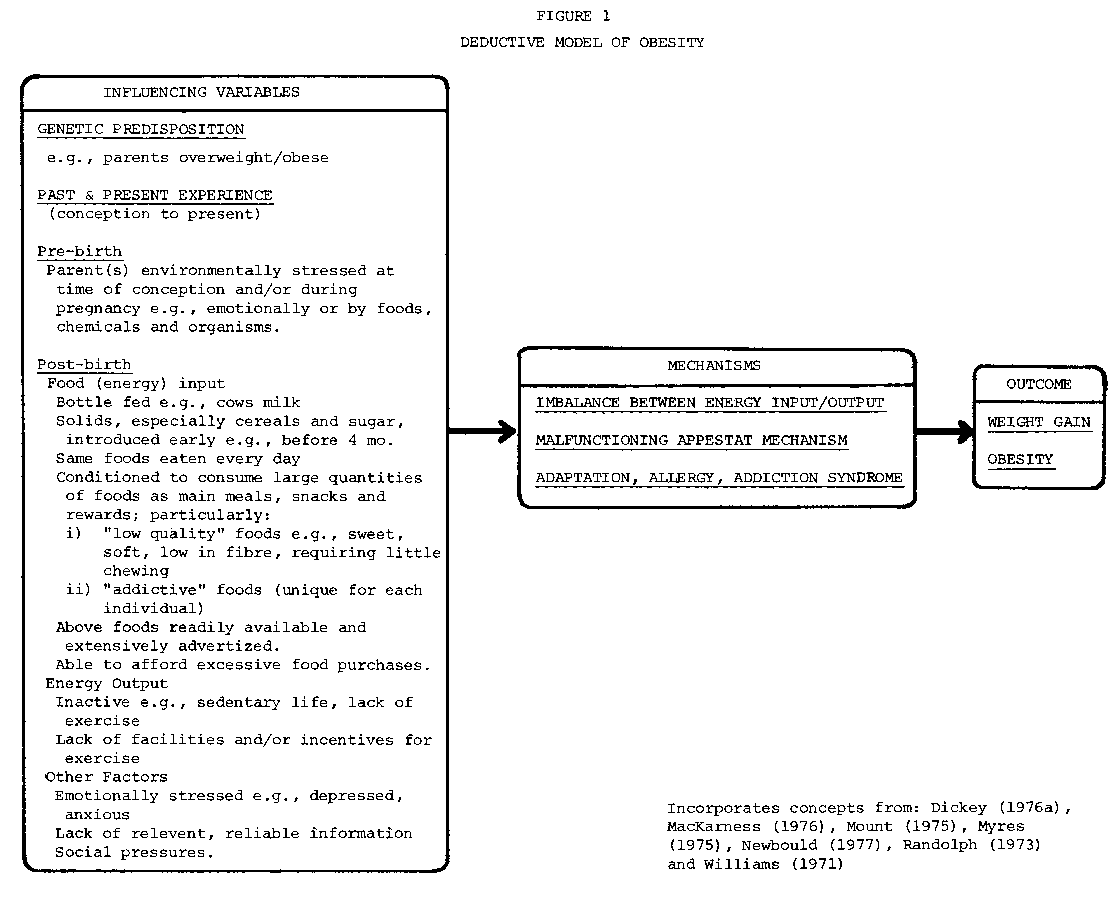
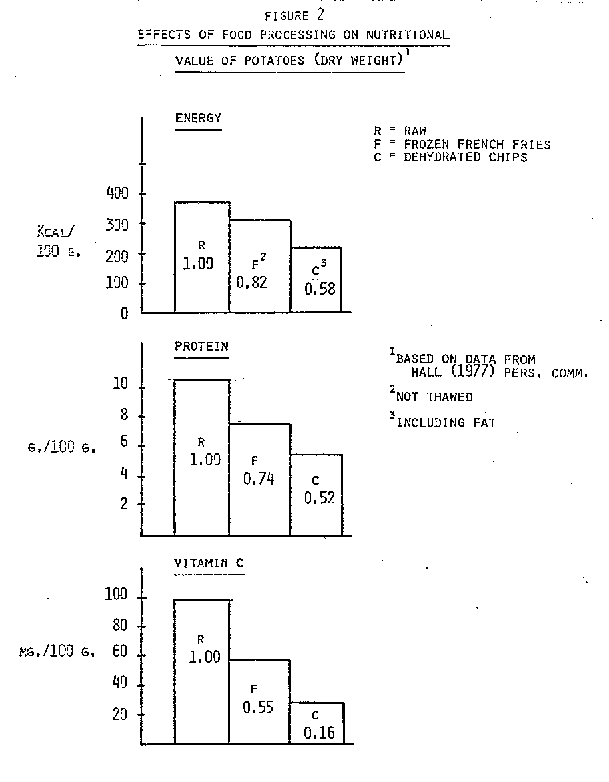
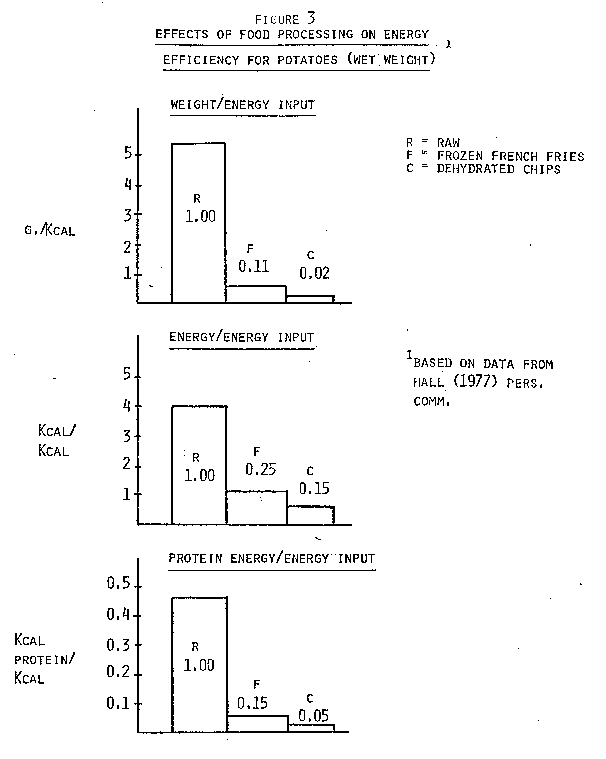
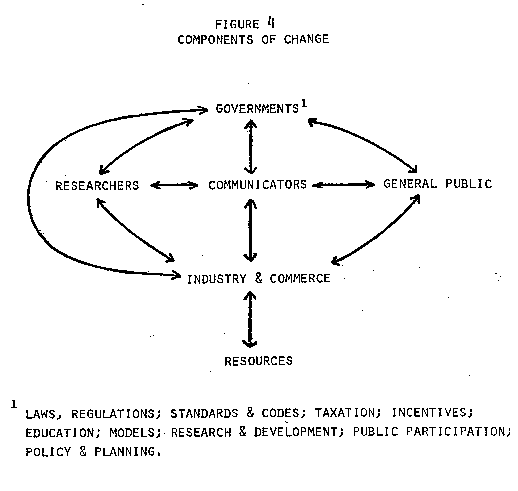
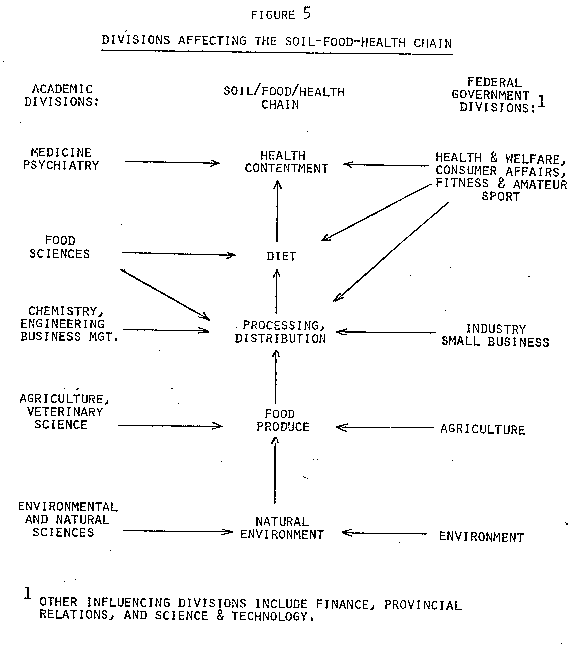
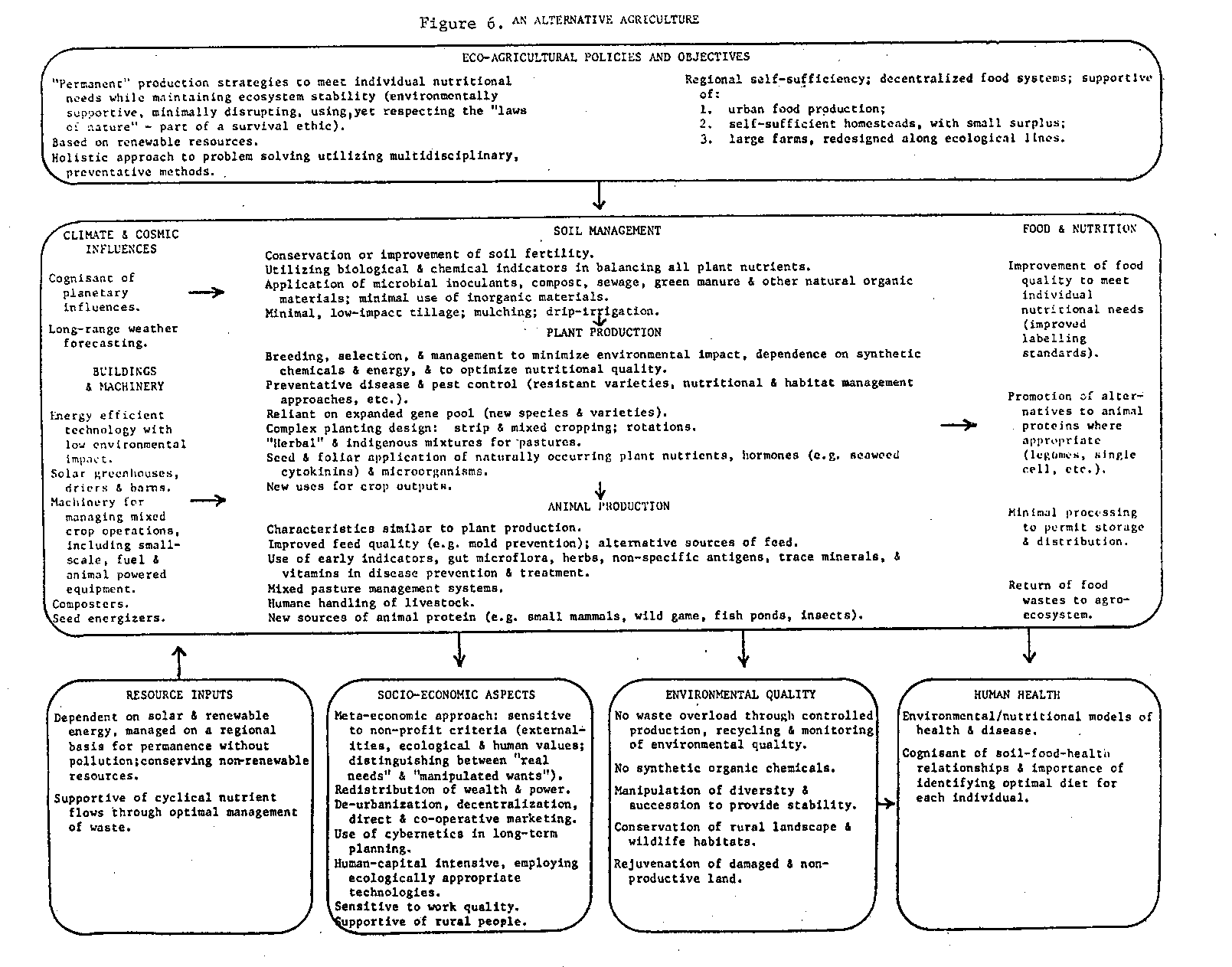
ADOLPH, E.F.. 1956. General and specific characteristics of physiological adaptation. Amer. J. Physiol.. 184: 18-28.
BALFOUR, Lady Eve B. 1975. The Living Soil and the Haughley Experiment. 383 pp. Faber & Faber, Lond..
BELDEN,, J. & G. Forte. 1976. Towards a National Food Policy. 228 pp. Exploratory Project for Economic Alternatives, Wash.,DC.
BELL, I.R.. 1975a. A kinin model of medication for food and chemical sensitivities: biobehavioural implications. Ann. Allergy 35: 206-215.
BELL, I.R.. 1975b.. Hypothalmic model of addiction and ecologic mental illness. 23 pp. manuscript. 9th Adv.. Seminar Clin.. Ecol.. (Toronto).
BINKLEY, E.L.. 1977. Ecology; The Unborn Child and Infant Feeding. 3 pp. abstract. 11th. Adv.. Seminar. Clin.. Ecol.. (San Francisco).
BINKLEY, E.L.. & D. Stigler. 1976. Food allergies in infants, prophylaxis with rotary diversified diet. Pp. 647-649 in L.D.. Dickey, ed.. Clinical Ecology. Thomas, Springfield, IL.
BID-DYNAMIC FARMING & GARDENING ASSOCIATION. Richmond Townhouse Rd., Wyoming, RI. 02898.
BLANCHET, M. 1977a. Une politique québecoise en matière de nutrition. 89 pp. Min. Affaires Soc.,., Que.
BLANCHET, M. 1977b.. A nutrition policy for Quebec. 17 pp. Unpublished paper presented to Symposium "Nutrition of the 1980's". Montreal, 30th Sept., 1977.
BOOKCHIN, M. 1971. CA. Post Scarcity Anarchism. 288 pp. Ramparts, Berkeley.
CHEN, K. & K.F.. Lagler, eds.. 1974. Growth Policy: Population Environment and Beyond. 237 pp. U. Mich.. Pr., MI.
COMMONER, B. 1970. The ecological facts of life. Pp. 18-35 in H.D.. Johnson, ed. No deposit - No return. Addison-Wesley, Reading, MA.
CORWIN, A.H. 1976. The rotating diet and taxonomy. Pp. 122-148 in L.D.. Dickey ea., Clinical Ecology. Thomas, Springfield, IL.
CROOK, W.G. 1974. Your Allergic Child. 171 pp. Pedicenter, Jackson, TN.
DANSEREAU, P. 1966. Ecological impact and human ecology. Pp. 425-462 in F.F.. Darling, and J.P.. Milton, eds. Future Environments of North America. Nat. Hist.. Pr.,., NY.
DICKEY, L.D. ed. 1976a. Clinical Ecology. 807 pp. Thomas, Springfield, IL.
DICKEY, L.D. 1976b. Presenting, reproduced, induced, and relieved symptoms observed with provocative tests. Pp. 152-155 in L.D.. Dickey, ed, Clinical Ecology. Thomas, Springfield, IL.
DICKEY, L.D.. 1976c. The individual delibrate feeding test. Pp. 397-401 in L.D. Dickey, ed. Clinical Ecology. Thomas, Springfield, IL.
DUBOS, R. 1959. Mirage of Health; Utopias, Progress and Biological Change. 282 pp. Harper & Row, NY.
ETTÉ, A. & J. Bower. 1975. Agriculture as part of a life-style in accord with natural laws. 3 pp. Farm and Food Society, Lond.
FLETMAN, J. 1974. What processing has done to the potato. Organic Food Marketing (February), pp. 6-7.
GERRARD, J.W. 1973. Understanding Allergies. 77 pp. Thomas, Springfield, IL.
GOLDS, N. 1975. Management of Complex Allergies. The Patient's Guide. 189 pp. New England Foundation of Allergic and Environmental Diseases. Norwalk, CT.
HALL, R.H. 1974. Food for Nought. The Decline in Nutrition. 292 pp. Random House, NY.
HALL, R.H. 1977. Personal communication. Dept. of Biochemistry, School of Medicine, McMaster University, Hamilton, Ont.
HEAL. 1977. Ecologist: A National Environmental Health Newsletter (3 issues/yr.) Human Ecology Action League, 4054 McKinney Ave. Suite 310, Dallas, TX.
HILL, S.B. 1977a (in press). Agricultural chemicals and the soil. 40 pp. Manuscript presented at Chemical and Agriculture: Problems and Alternatives Conference. Fort Qu'Appelle, Saskatchewan, 3rd Nov., 1977.
HILL, S.B. 1977b (in press). Ecology. 14 pp. Manuscript for presentation to: The Parliamentary and Scientific Committee, Food From Land II: Non-Animal Protein. Ottawa, 30th Nov., 1977.
HILL, S.B. & J.A. Ramsay. 1977a. Energy and the Canadian Food System with Particular Reference to New Brunswick. 181 pp. Unpublished report to the Government of New Brunswick, Agricultural Resources Study.
HILL, S.B. & J.A. Ramsay. 1977b. Limitations of the energy approach in defining priorities in agriculture. Pp. 713-731 in W. Lockeretz, ed. Agriculture and Energy. Academic Pr., NY.
KULVINSKAS, V. 1976. Survival into the 21st Century. 318 pp. Omangod, Wethersfield, CT.
LAPPE, F.M. 1975. Diet for a Small Planet. 2nd ed. 411 pp. Ballantine, NY.
MACKARNESS, R. 1976. Not All in the Mind. 159 pp. Pan, Lond.
MERRILL, R., ed. 1976. Radical Agriculture. 459 pp. Harper & Row, NY.
MONTREAL STAR. 1977. Attack on junk food launched. Quebec diets too sweet. (report by Valerie Gregory, Sept. 10, p. 1).
MOUNT, J.L. 1975. Food and Health of Western Man. 270 pp. Charles Knight, Lond.
MYRES, A.W. 1975. Obesity: is it preventable in infancy and childhood? Can. Fam. Phy. 21(4): 73-77.
NEWBOLD, H.L. 1977. Dr. Newbold's Revolutionary New Discoveries About Weight Loss. 274 pp. Rawson, NY.
NUTRITION CANADA. 1975. Provincial, Indian and Eskimo Surveys (12 volumes). Queen's Printer, Ottawa.
OSKI, F.A. & J.D. Bell. 1977. Don't Drink Milk! The Frightening New Medical Facts About the World's Most Overrated Nutrient. 154 pp. Wyden Books, NY.
PRICE-POTTENGER NUTRITION FOUNDATION, 5622 Dartford Way, San Diego, 92120 CA.
PYE RESEARCH CENTRE, Haughley Research Farms Ltd., Walnut Tree Manor, Haughley, Stowmarket, Suffolk 1P14 3RS, England.
RANDOLPH, T.G. 1962. Human ecology and susceptibility to the chemical environment. 148 pp. Thomas, Springfield, IL.
RANDOLPH, T.G. 1973. Bulletin of The Human Ecology Research Foundation. 69 pp. Chicago, IL.
RANDOLPH, T.G. 1976a. Historical development of clinical ecology. Pp. 9-17 in L.D. Dickey, ed. Clinical Ecology. Thomas, Springfield, IL.
RANDOLPH, T.G. 1976b. Stimulatory and withdrawal levels and the alterations of allergic manifestations. Pp. 156-175 in L.D. Dickey, ed. Clinical Ecology. Thomas, Springfield, IL.
RAPP, D.J. 1975. How to detect food sensitivity. 47 pp. Syntex, Palo Alto, CA.
RESEARCH INSTITUTE OF BIOLOGICAL HUSBANDRY, Postfach, 4104 Oberwill BL, Switzerland.
RINKEL, H.J., T.G. Randolph and M. Zeller. 1951. Food Allergy. 492 pp. Thomas, Springfield, IL.
ROWE, A.H. & A. Rowe Jr. 1972. Food Allergy (Its Manifestations and Control and the Elimination Diets) - A Compendium. 687 pp. Thomas, Springfield, IL.
ROYAL NORWEGIAN MINISTRY OF AGRICULTURE. 1976. On Norwegian nutrition and food policy. 80 pp. Report No. 32 to the Storting (1975-76).
SELYE, H. 1965. The Stress of Life. 324 pp. McGraw Hill, NY.
WHELAN, E.F. and A.C. Abbott. Agriculture Canada, Ottawa. 1977. A food strategy for Canada. 21 pp.
WILLIAMS, R.J. 1956. Biochemical Individuality. 214 pp. University of Texas Pr., Austin, TX.
WILLIAMS, R.J. 1971. Nutrition Against Disease: Environmental Prevention. 370 pp. Pitman, NY.
WOOD, Jr., H.C. 1971. Overfed but Undernourished. Tower Publications Inc., 185 Madison Ave., New York, N.Y. 10016. 252 pp.
Copyright 1987 Ecological Agriculture Projects
Info Request | Services | Become EAP Member | Site Map
Give us your comments about the EAP site
Ecological Agriculture Projects, McGill University (Macdonald
Campus)
Ste-Anne-de-Bellevue, QC, H9X 3V9 Canada
Telephone:
(514)-398-7771
Fax:
(514)-398-7621
Email: eapinfo@macdonald.mcgill.ca
To report problems or otherwise comment on the structure of this site, send mail to the Webmaster